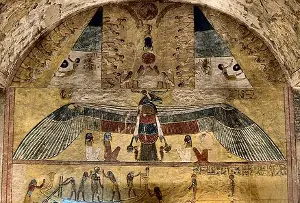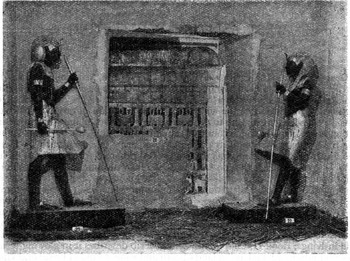Ancient Egypt's Valley of the Kings
The Ancient Egyptians revered their kings and so answered the call that many rulers issued for constructing sometimes large burial buildings. The earliest kings were buried at Abydos. Later kings were buried at Giza and Saqqara. 
From the 16th Century B.C. to the 11th Century B.C., the kings of Ancient Egypt ordered built tombs for themselves in the Valley of the Kings, a large burial area within the necropolis on the western bank of the Nile River, across from the city of Thebes. In the Valley of the Kings are the tombs of several dozen pharaohs, from Thutmose I to Ramses XI. Also buried in the Valley of the Kings were wives and children of the pharaohs, as well as nobles whom the kings found important. The later-built Valley of the Queens contains tombs for several important royal wives. Construction of the tombs generally followed a similar pattern. The focus was a lower chamber that contained the sarcophagus. Outside that was an antechamber. The rest of the tomb was a number of corridors, usually three. In general, the building of such a tomb took six years to complete. The workers used basic tools like chisels, hammers, picks, and shovels, made of bone, copper, ivory, stone, and wood. Where they could, they took advantage of existing recesses and other spaces. On the walls of the tombs were various images, depicting the gods of Egypt and the rulers themselves, and various hieroglyphs, including many writings like the Book of the Dead that were concerned with the king's journey into the afterlife. Also known is that the people who built the tombs in the Valley of the Kings lived in a nearby town named Deir El Medina.  Some of the most famous of Egypt's rulers were among the 60 who were buried in the Valley of the Kings, including:

Perhaps the most famous tomb found in the Valley of the Kings was that of Tutankhamen, also known as "King Tut." Although the famous "Boy King" ruled for only a decade, he is much more well-known for what was found in his tomb, discovered in 1922. Indeed, those who opened the tomb and catalogued the contents found not only the famous golden sarcophagus and golden funerary mask but also more than 5,000 artifacts, including clothes, weapons, furnitures, chariots, and (one study concluded) a prototype of the modern camping bed. One remarkable fact about King Tut's tomb is that its contents were intact. This was not the case with most kings' tombs because grave-robbing was quite common. Despite the presence of the military police-like Medjay, the pharaohs relied more on elements like false passages built within the tombs, the belief that grave-robbing incurred curses for the perpetrators, and the overall inhospitable climate of the area to discourage those looking for plunder. Archaeologists have also found many examples of ancient graffiti written on the walls of some of the tombs. The tomb of Ramses VI has more than 1,000 such scrawls. |
|
Social Studies for Kids
copyright 2002–2024
David White




